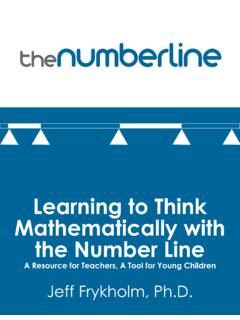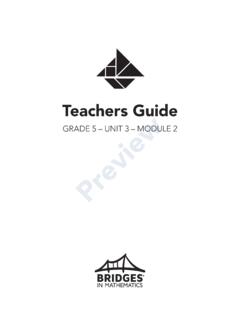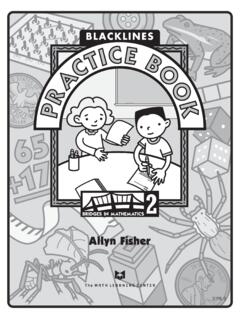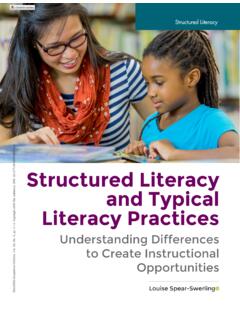Transcription of Learning to Think Mathematically with the Ratio Table
1 Learning to ThinkMathematically withthe Ratio TableJeff Frykholm, Resource for Teachers, A Tool for Young ChildrenLearning to Think Mathematically with the Ratio Table A Resource for Teachers, A Tool for Young Children by Jeffrey Frykholm, by The Math Learning Center 2013 The Math Learning Center. All rights reserved. The Math Learning Center, PO Box 12929, Salem, Oregon 97309. Tel 1 (800) 575-8130 published in 2013 by Cloudbreak Publishing, Inc., Boulder, Colorado (ISBN 978-0-615-73996-0)The Math Learning Center grants permission to reproduce and share print copies or electronic copies of the materials in this publication for educational purposes. For usage questions, please contact The Math Learning Math Learning Center grants permission to writers to quote passages and illustrations, with attribution, for academic publications or research purposes. Suggested attribution: Learning to Think Mathematically with the Ratio Table , Jeffrey Frykholm, Math Learning Center is a nonprofit organization serving the education community.
2 Our mission is to inspire and enable individuals to discover and develop their mathematical confidence and ability. We offer innovative and standards-based professional development, curriculum, materials, and resources to support Learning and teaching. ISBN: 978-1-60262-568-6 Learning to Think Mathematically with the Ratio TableA Resource for Teachers, A Tool for Young ChildrenAuthored by Jeffrey Frykholm, : This book prepares teachers with the theoretical basis, practical knowledge , and expertise to use the Ratio Table as a vigorous model for mathematical Learning in grades K 8. A growing body of research in mathematics education points to the Ratio Table as a fundamentally important model for elementary and middle school learners as we prepare them for success in the beginning algebra course. The Ratio Table serves as a visual representation a structural model that embodies numerous concepts and relationships. This versatile tool promotes proportional reasoning, makes use of equivalent fractions, represents percents, functions as a double number line, and can perform as an elegant computational tool in contexts that require either multiplication or division.
3 Learning to Think Mathematically with the Ratio Table 2 About the Author Dr. Jeffrey Frykholm has had a long career in mathematics education as a teacher in the public school context, as well as a professor of mathematics education at three universities across the Dr. Frykholm has spent the last 22 years of his career teaching young children, working with beginning teachers in preservice teacher preparation courses, providing professional development support for practicing teachers, and working to improve mathematics education policy and practices across the globe (in the , Africa, South America, Central America, and the Caribbean). Dr. Frykholm has authored over 30 articles in various math and science education journals for both practicing teachers, and educational researchers. He has been a part of research teams that have won in excess of six million dollars in grant funding to support research in mathematics education.
4 He also has extensive experience in curriculum development, serving on the NCTM Navigations series writing team, and having authored two highly regarded curriculum programs: An integrated math and science, K-4 program entitled Earth Systems Connections (funded by NASA in 2005), and an innovative middle grades program entitled, Inside Math (Cambium Learning , 2009). This book, Learning to Think Mathematically with the Ratio Table , is part of his latest series of textbooks for teachers. Other books in this series include: Learning to Think Mathematically with the Rekenrek; Learning to Think Mathematically with the Number Line; Learning to Think Mathematically with Multiplication Models; and Learning to Think Mathematically with the Double Number Line. Dr. Frykholm was a recipient of the highly prestigious National Academy of Education Spencer Foundation Fellowship, as well as a Fulbright Fellowship in Santiago, Chile to teach and research in mathematics education.
5 Learning to Think Mathematically with the Ratio Table 3 Table of Contents Learning TO Think Mathematically : AN INTRODUCTION 4 The Learning to Think Mathematically Series 4 How to Use this Book 4 THE Ratio Table : AN OVERVIEW 7 CHAPTER 1: MENTAL MATH AND THE Ratio Table 11 Strategy 1: Multiplying by 10 12 Strategy 2: Multiplying by any number 13 Strategy 3: Doubling 14 Strategy 4: Halving 15 Strategy 5: Combining Columns (Adding and Subtracting) 16 Chapter 1 Activity Sheets 19 CHAPTER 2: MULTI-DIGIT MULTIPLICATION WITH THE Ratio Table 30 Chapter 2 Activity Sheets 34 CHAPTER 3: DIVISION WITH THE Ratio Table 37 Chapter 3 Activity Sheets 42 CHAPTER 4: FRACTIONS AND THE Ratio Table 45 Chapter 4 Activity Sheets 47 APPENDIX: APPLICATIONS WITH THE Ratio Table 49 Learning to Think Mathematically with the Ratio Table 4 Learning to Think Mathematically : An Introduction The Learning to Think Mathematically Series One driving goal for K-8 mathematics education is to help children develop a rich understanding of numbers their meanings, their relationships to one another, and how we operate with them.
6 In recent years, there has been growing interest in mathematical models as a means to help children develop such number sense. These models ( , the number line, the rekenrek, the Ratio Table ) are instrumental in helping children develop structures or ways of seeing mathematical concepts. This textbook series has been designed to introduce some of these models to teachers perhaps for the first time, perhaps as a refresher and to help teachers develop the expertise to implement these models effectively with children. While the approaches shared in these books are unique, they are also easily connected to more traditional strategies for teaching mathematics and for developing number sense. Toward that end, we hope they will be helpful resources for your teaching. In short, these books are designed with the hope that they will support teachers content knowledge and pedagogical expertise toward the goal of providing a meaningful and powerful mathematics education for all children.
7 How to Use this Book This is not a typical textbook. While it does contain a number of activities for students, the intent of the book is to provide teachers with a wide variety of ideas and examples that might be used to further their ability and interest in teaching with Ratio tables. The book contains ideas about how the Ratio Table can be used to multiply, to divide, to combine equivalent ratios, to model equivalent fractions, and to structure informal mental math strategies, among other things. Each chapter has a blend of teaching ideas, mathematical ideas, examples, and specific problems for children to engage as they learn to use the Ratio Table as a mathematical structure. So in the traditional sense, this is not a fifth grade book, for example. Ideas have been divided into several themes strategies for appropriate use of the Ratio Table , as well as specific applications of the Ratio Table toward common mathematical tasks.
8 We hope that teachers will apply their own expertise and craft knowledge to these explanations and activities to make them relevant, appropriate (and better!) in the context of their own classrooms. In many cases, a lesson may be extended to a higher grade level, or perhaps modified for use with students who may need additional support. Ideas toward those pedagogical adaptations are provided throughout. Learning to Think Mathematically with the Ratio Table 5 Book Chapters and Content This book is divided into five sections. The first chapter, Mental Math and the Ratio Table , provides the operational building blocks upon which successful work with the Ratio Table may begin. This chapter introduces students to the key mental strategies they may employ to use Ratio tables effectively. The second chapter, Multiplication with the Ratio Table , illustrates how children may complete two and three-digit multiplication problems with the Ratio Table .
9 Building on common strategies learned in Chapter 1 ( , multiplying by 10, doubling, halving, etc.), students develop powerful techniques with the Ratio Table that they may choose as an alternative to the traditional multiplication algorithm. The benefit of the Ratio Table as a computational tool is its transparency, as well as its fundamental link to the very nature of multiplication. Multiplication is often described to young learners as repeated addition. Yet, this simple message is often clouded when students learn the traditional multiplication algorithm. A young learner would be hard pressed to recognize the link between the traditional algorithm and repeated addition as they split numbers, put down the zero , carry , and follow other steps in the standard algorithm that, in truth, hide the very simple multiplicative principle of repeated addition. In contrast, the Ratio Table builds fundamentally on the idea of groups and repeated addition.
10 With time and practice, students develop remarkably efficient and effective problem solving strategies to multiply two and three-digit numbers with both accuracy, and with conceptual understanding. The third chapter, Division with the Ratio Table , similarly provides an alternative to the traditional, long division algorithm. Building on the intuitive computational strategies developed in Chapter 1, and drawing on students intuitions about the nature of division as a fair share, Chapter 3 provides students with a method for dividing that allows them to make meaning of the process in a way that is not often available with the traditional long division algorithm. Ratio Table division uses a process very similar to how a child might multiply with the Ratio Table . Hence, another advantage of the Ratio Table as a computational tool is its similar application across problem types. While a young student would be hard pressed to see connections between the long division algorithm and the multi-digit multiplication algorithm, multiplication and division with the Ratio Table are very similar processes.










